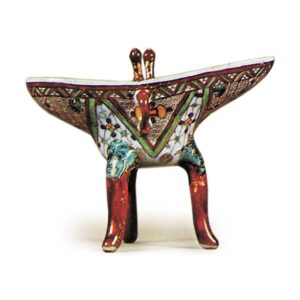
A drinking vessel from the Zhou dynasty of China. It has the most unusual form of all ancient Chinese drinking vessels and the most flamboyant artistic form of all ancient bronze vessels. The bronze baron resembles an inverted Western helmet, with a pointed tail at one end and a long stream at the other end, and two columns in the center. The side of the vessel has a handle and rests on three pointed legs. The “Setsuwen” says, “The elephant on a knight’s head is a sparrow that is always singing and has many legs. The Chinese character for “baron” is the same as the Chinese character for “sparrow. The lower part of a sparrow is in order, but the upper part is the opposite. The sparrow is a small one. It is said that this vessel represents the shape of a sparrow, indicating that it flies well and does not drown, or that it is a warning against drinking heavily so that one can drink as little as a sparrow. The form of the vessel is probably derived from a beast horn, but whether or not it was copied on earthenware, changed during that time, and then returned to metal, as in the case of many other vessels, it is undeniable that the development of earthenware indirectly influenced the production of all types of bronze vessels, but the unglazed earthenware is not a vessel for serving or drinking wine, and is not a vessel for drinking wine. However, since unglazed earthenware is not considered suitable for serving or drinking sake due to its permeability and a kind of earthy odor, it is likely that animal horns with a pleasant mouth feel were used for a long time as actual drinking vessels, except for ritual mourning and funerary ceremonies. The three-legged baron, which was not simply a drinking vessel but a ceremonial vessel with three legs, may have been attached to the earthenware form of a baron like the three legs of a ding, which had already been established. In this respect, it is quite instructive that Yi Ji considered the earthenware baron form found in the ruins of Yin in Anyang, Henan Province to be an early and ancient form of the bronze baron and illustrated the performance of the baron form, while others consider it a simplified copy of the bronze baron (see “Anyang Excavation Report,” Phase III. (See “Overhead Burial” in “Anyang Excavation Report,” Phase III). The same type of baron-shaped earthenware is shown as pottery in Luo Zhengyu’s “Illustrated Catalogue of Ancient Ming Wares. All of these earthenware pieces lack pillars. The baron was said to hold one square (18 liters to a liter), and when lords and princes were given a baron, the emperor gave them a baron, which was divided into grades of jade, horn, gold, silver, and so on. This was the origin of the title of “nobility” in later times. Porcelain knights are also found in the Choryongsan kilns of Korea and other kilns of the same period. These were probably ceremonial vessels. The use of dukes as drinking vessels flourished during the Zhou dynasty and disappeared with the introduction of cups, but they have retained their form in incense burners in later periods. The Japanese reading is “sakazuki.



